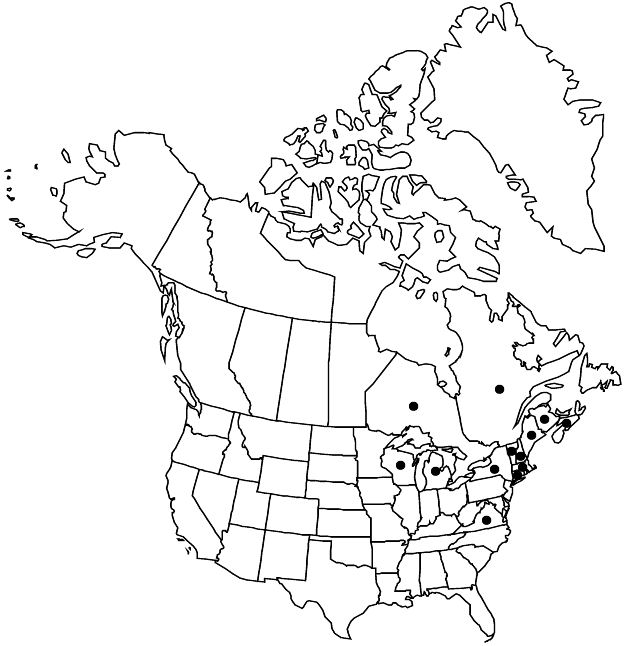Difference between revisions of "Crataegus scabrida"
Rhodora 3: 29. 1901.
FNA>Volume Importer |
RevisionBot (talk | contribs) m (Bot: Adding category Revised Since Print) |
||
| (8 intermediate revisions by 3 users not shown) | |||
| Line 16: | Line 16: | ||
|name=Crataegus brainerdii var. scabrida | |name=Crataegus brainerdii var. scabrida | ||
|authority=(Sargent) Eggleston | |authority=(Sargent) Eggleston | ||
| + | |rank=variety | ||
}} | }} | ||
|hierarchy=Rosaceae;Rosaceae subfam. Amygdaloideae;Rosaceae tribe Gillenieae;Crataegus;Crataegus sect. Macracanthae;Crataegus (sect. Macracanthae) ser. Anomalae;Crataegus scabrida | |hierarchy=Rosaceae;Rosaceae subfam. Amygdaloideae;Rosaceae tribe Gillenieae;Crataegus;Crataegus sect. Macracanthae;Crataegus (sect. Macracanthae) ser. Anomalae;Crataegus scabrida | ||
| Line 27: | Line 28: | ||
-->{{Treatment/Body | -->{{Treatment/Body | ||
| − | |distribution= | + | |distribution=N.B.;N.S.;Ont.;Que.;Conn.;Maine;Mass.;Mich.;N.H.;N.Y.;Va.;Vt.;Wis. |
|discussion=<p>Varieties 4 (4 in the flora).</p><!-- | |discussion=<p>Varieties 4 (4 in the flora).</p><!-- | ||
| − | --><p>Crataegus scabrida is variable in leaf shape and size, as well as in pubescence of adaxial leaf surfaces and pedicels. The species falls into four reasonably well-marked varieties, only the first two of which are frequent. The range of the species as a whole is somewhat poorly documented because of frequent incorrect identification.</p> | + | --><p><i>Crataegus scabrida</i> is variable in leaf shape and size, as well as in pubescence of adaxial leaf surfaces and pedicels. The species falls into four reasonably well-marked varieties, only the first two of which are frequent. The range of the species as a whole is somewhat poorly documented because of frequent incorrect identification.</p> |
|tables= | |tables= | ||
|references= | |references= | ||
| Line 68: | Line 69: | ||
-->{{#Taxon: | -->{{#Taxon: | ||
name=Crataegus scabrida | name=Crataegus scabrida | ||
| − | |||
|authority=Sargent | |authority=Sargent | ||
|rank=species | |rank=species | ||
| Line 75: | Line 75: | ||
|basionyms= | |basionyms= | ||
|family=Rosaceae | |family=Rosaceae | ||
| − | |distribution= | + | |distribution=N.B.;N.S.;Ont.;Que.;Conn.;Maine;Mass.;Mich.;N.H.;N.Y.;Va.;Vt.;Wis. |
|reference=None | |reference=None | ||
|publication title=Rhodora | |publication title=Rhodora | ||
|publication year=1901 | |publication year=1901 | ||
|special status=Endemic | |special status=Endemic | ||
| − | |source xml=https:// | + | |source xml=https://bitbucket.org/aafc-mbb/fna-data-curation/src/2e0870ddd59836b60bcf96646a41e87ea5a5943a/coarse_grained_fna_xml/V9/V9_885.xml |
|subfamily=Rosaceae subfam. Amygdaloideae | |subfamily=Rosaceae subfam. Amygdaloideae | ||
|tribe=Rosaceae tribe Gillenieae | |tribe=Rosaceae tribe Gillenieae | ||
| Line 89: | Line 89: | ||
}}<!-- | }}<!-- | ||
| − | -->[[Category:Treatment]][[Category:Crataegus (sect. Macracanthae) ser. Anomalae]] | + | --> |
| + | |||
| + | [[Category:Treatment]] | ||
| + | [[Category:Crataegus (sect. Macracanthae) ser. Anomalae]] | ||
| + | [[Category:Revised Since Print]] | ||
Latest revision as of 18:07, 6 November 2020
Shrubs, 30–50 dm. Stems: twigs: new growth reddish early, glabrous, 1-year old deep tan, 2-years old tan to deep reddish brown, older dull gray; thorns on twigs at 1-year old shiny, dark brown to nearly black, stout or slender, 4–6 cm. Leaves: petiole slender, length 40–60% blade, sparsely pubescent or glabrous, eglandular or sessile-glandular; blade short-ovate to ovate, broadly elliptic to narrowly rhombic, or ± trullate, 3–8 cm, base rounded to cuneate, lobes 3–5 per side, margins serrate, veins 5–7(or 8) per side, apex acute, abaxial surface glabrous, adaxial sparsely to densely appressed-pubescent young, glabrescent. Inflorescences 6–10-flowered; branches glabrous or villous. Flowers 15–18 mm diam.; hypanthium glabrous or pubescent; sepals narrowly triangular, margins subentire or glandular-serrate; stamens 7 or 8(–10), anthers pink; styles 3 or 4. Pomes reddish or orange-red, suborbicular, 6–9 mm diam., pruinose, glabrous or slightly pubescent; sepals spreading to ± erose; pyrenes 2–4, sides often pitted. 2n = 51.
Distribution

N.B., N.S., Ont., Que., Conn., Maine, Mass., Mich., N.H., N.Y., Va., Vt., Wis.
Discussion
Varieties 4 (4 in the flora).
Crataegus scabrida is variable in leaf shape and size, as well as in pubescence of adaxial leaf surfaces and pedicels. The species falls into four reasonably well-marked varieties, only the first two of which are frequent. The range of the species as a whole is somewhat poorly documented because of frequent incorrect identification.
Selected References
None.
Lower Taxa
Key
| 1 | Inflorescence branches glabrous | > 2 |
| 1 | Inflorescence branches villous | > 3 |
| 2 | Leaf blades ovate to narrowly rhombic, 4–7 cm. | Crataegus scabrida var. scabrida |
| 2 | Leaf blades broadly elliptic, 3–5 cm. | Crataegus scabrida var. cyclophylla |
| 3 | Leaf blades trullate or broadly trullate, 5–8 cm. | Crataegus scabrida var. asperifolia |
| 3 | Leaf blades short-ovate to broadly elliptic, 4 cm. | Crataegus scabrida var. egglestonii |